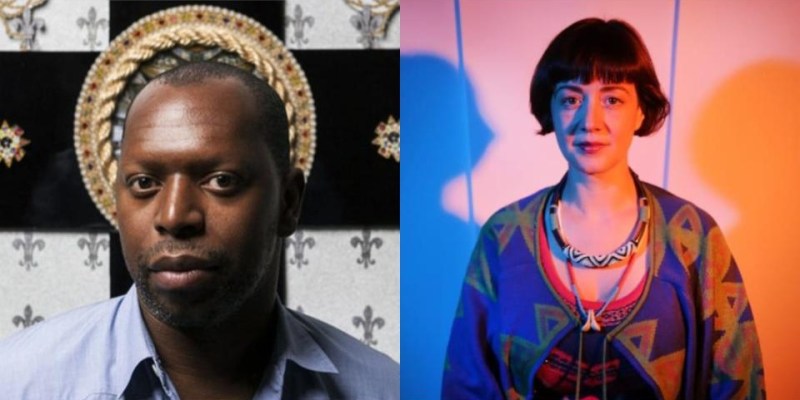In the first event of spring quarter, Stanford Art Institute’s Arts + Justice workshop focused on the technologies of justice, emphasizing the humanistic potential and uncertainty of artificial intelligence. Moderated by Michele Elam of Stanford’s English Department, visiting artists Rashaad Newsome and Amelia Winger-Bearskin discussed their practices and how they use virtual and visceral modes of engagement to create new experiences.
Rashaad Newsome’s work — which incorporates collage, sculpture, film, photography, music, computer programming, software engineering, community organizing and performance — creates a new field that rejects classification. Using the diasporic traditions of improvisation and collage, he pulls from the world of advertising, the Internet, art history, Black culture and queer culture to produce work that uses creative computing, social practice, abstraction and intersectionality. Newsome’s work celebrates Black contributions to the art canon while creating innovative and inclusive forms of culture and media.
One of the projects Newsome discussed was the AI persona he created named “Being.” Described as “The Digital Griot,” this virtual assistant’s mind has been populated with the works of radical authors and theorists. Its interactions were further influenced by the crowd present at its debut exhibition, “To Be Real,” at the Philadelphia Photo Arts Center. The preservation of works through AI not only surpasses the boundaries of how history is shared, but also, as tech continues to expand, asserts the importance of this community’s history in the future.
His multimedia performance “Five Elements of Vogue” further explores power, gender and beauty. Newsome uses digital data, 3D printing, collage and traditional lithography to create abstract prints of character and gestures of five vogue femme dancers.
When asked how he engages with technology, Newsome replied that he uses animation, design, computer science, AI and programming to push the limits of art and go as “far as your mind can go.” In thinking creatively, he thrives within the contemporary art canon whilst emphasizing elements of Black culture.
Newsome also spoke of how art practice puts pressure on different technologies by exploring the limits of our current knowledge systems. Examining what we know and the potential learning we can achieve through art both serve as a mode of healing as we create our narrative. It is urgent that we respond to the systems that oppress our voices, he said.
The latter artist Amelia Winger-Bearskin, while traditionally a performance artist, is also an indigenous visual artist and technologist who helps communities leverage emerging technologies to effect positive change in the world.
In his day-to-day work, Winger-Bearskin creates cities using virtual reality (VR) technologies; she is also a founder of IDEA New Rochelle, an NGO which partnered with the New Rochelle Mayor’s office to develop citizen-focused VR/AR tools. At the workshop event, she discussed and showed a VR experience named “Hopeful Worlds.” The project, with Wampum.codes, explores the creation of playful experiences with AI, VR and sound. The piece metaphorically describes shifting emotions, with abstract and colored visual components conveying a feeling of moving through space.
She also collaborated with artist Wendy Red Star on the “Monster’s Installation” at the Newark Museum. It was their version of a “Sweat Lodge” — a geodesic dome covered with Pendleton blankets, sleeping bags and various cut-and-sewn fabrics. Guests can enter the exhibit with the sound of the wind inviting them in. Through their research and interactions with indigenous tribes, Winger-Bearskin and Red Star were able to bring a piece of what seems far from the past into our current age and preserve current indigenous values.
Winger-Bearskin also showcased the VR beading, a colorful arrangement of moving images that combine to form a collective whole. Alongside these images, she discussed the Iroquois Confederacy and how their values of democracy were “twisted” in the making of the U.S. constitution — a twisting Winger-Bearskin described as a form of colonialism. She said that although we naturally have colonial mindsets due to the American culture, we are not “colonial subjects,” and that we need to actively remind ourselves to not colonize our future. Instead, she said, we should diversify our ideas with other cultures, not cherrypick ideas that already flatter our mindset.
When asked how she engages with technology, she explained that, through visual and auditory expression, the role of the artist is to change the world in different trajectories and democratize ideas. Her interactions with technology allow for unique modes of storytelling and engagement with unconventional forms. With this in mind, Winger-Bearskin’s art and activism aspire to impact generations ahead and provide a new code for communication.
Both Amelia Winger-Bearskin and Rashaad Newsome surpass the boundaries of what tech is traditionally used for, defying the conventions of what many view as art. With their inclusion of social justice ideas, they reimagine where the aesthetics of technology can intersect in art. Their work paves a path for future generations of artists and provides audiences with a new perspective for how we can change the world through technology and art.
